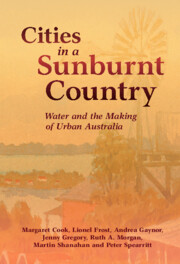Book contents
- Cities in a Sunburnt Country
- Studies in Environment and History
- Cities in a Sunburnt Country
- Copyright page
- Contents
- Figures
- Maps
- Book part
- Tables
- Acknowledgements
- 1 Prologue
- 2 Living Water
- 3 Domesticating Water
- 4 Keeping Up
- 5 Transforming Homes
- 6 Watering Suburbia
- 7 Crises of Confidence
- 8 Twenty-First Century Australian Cities
- 9 Epilogue
- References
- Index
- Studies in Environment and History
4 - Keeping Up
Published online by Cambridge University Press: 19 May 2022
- Cities in a Sunburnt Country
- Studies in Environment and History
- Cities in a Sunburnt Country
- Copyright page
- Contents
- Figures
- Maps
- Book part
- Tables
- Acknowledgements
- 1 Prologue
- 2 Living Water
- 3 Domesticating Water
- 4 Keeping Up
- 5 Transforming Homes
- 6 Watering Suburbia
- 7 Crises of Confidence
- 8 Twenty-First Century Australian Cities
- 9 Epilogue
- References
- Index
- Studies in Environment and History
Summary
In the first half of the twentieth century, Australian metropolitan water authorities faced the challenge of keeping up with rising demand for water and sewerage. State governments could draw on income tax revenue to fund infrastructure projects and subsidise water authorities, but the demands and expectations of new suburban households resulted in periodic water shortages and a reliance on septic tanks and pan collection in unsewered areas. Because water demand is habitual and culturally determined, governments responded to these shortages by imposing water restrictions and investing in large storage works. Each of the five cities was supplied with safe water at the end of World War II, but the provision of sewerage was uneven. Brisbane and Perth lagged; Sydney and Melbourne’s sewerage systems would struggle to cope with new demands in the post-War boom period.
Keywords
- Type
- Chapter
- Information
- Cities in a Sunburnt CountryWater and the Making of Urban Australia, pp. 81 - 104Publisher: Cambridge University PressPrint publication year: 2022

